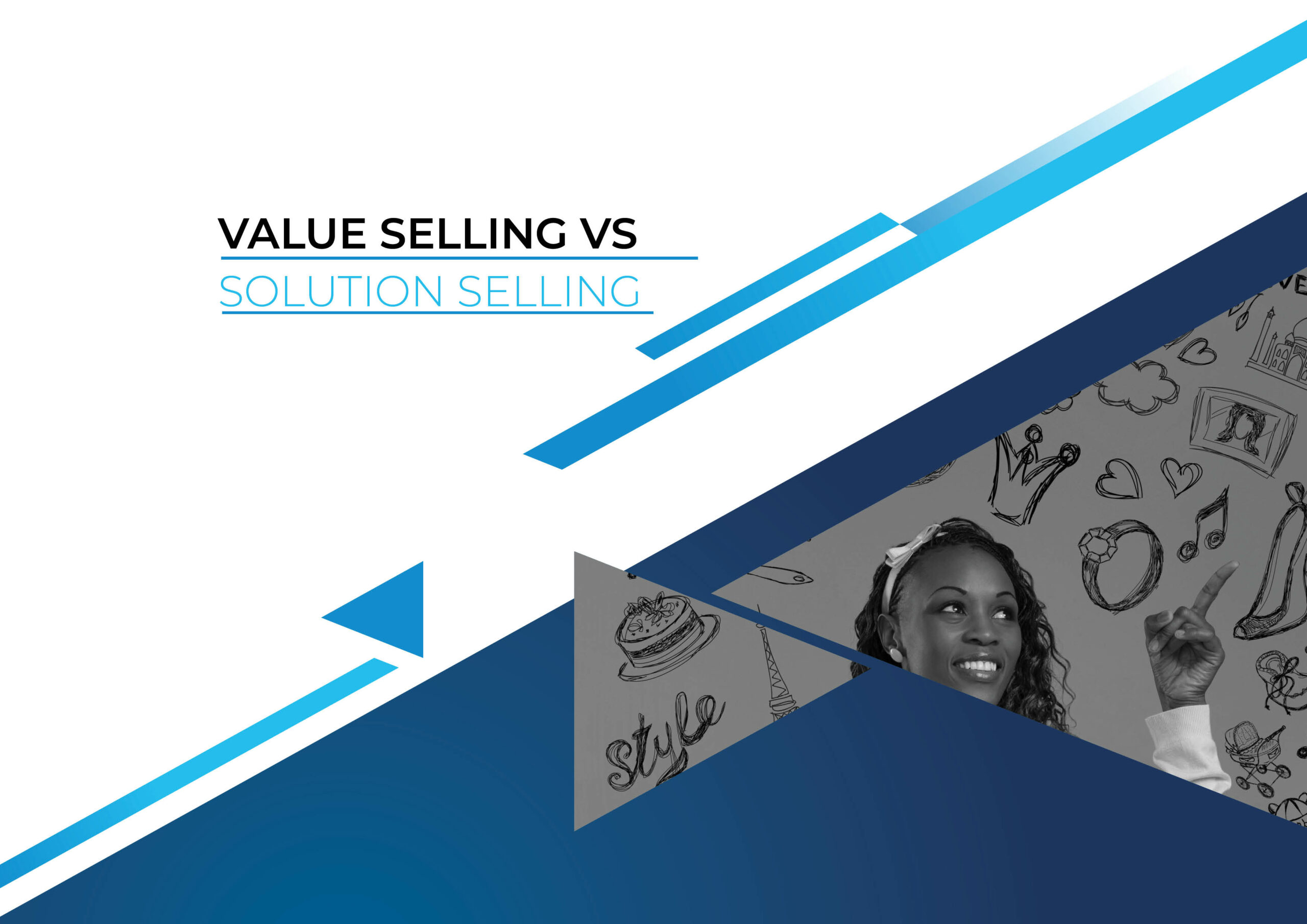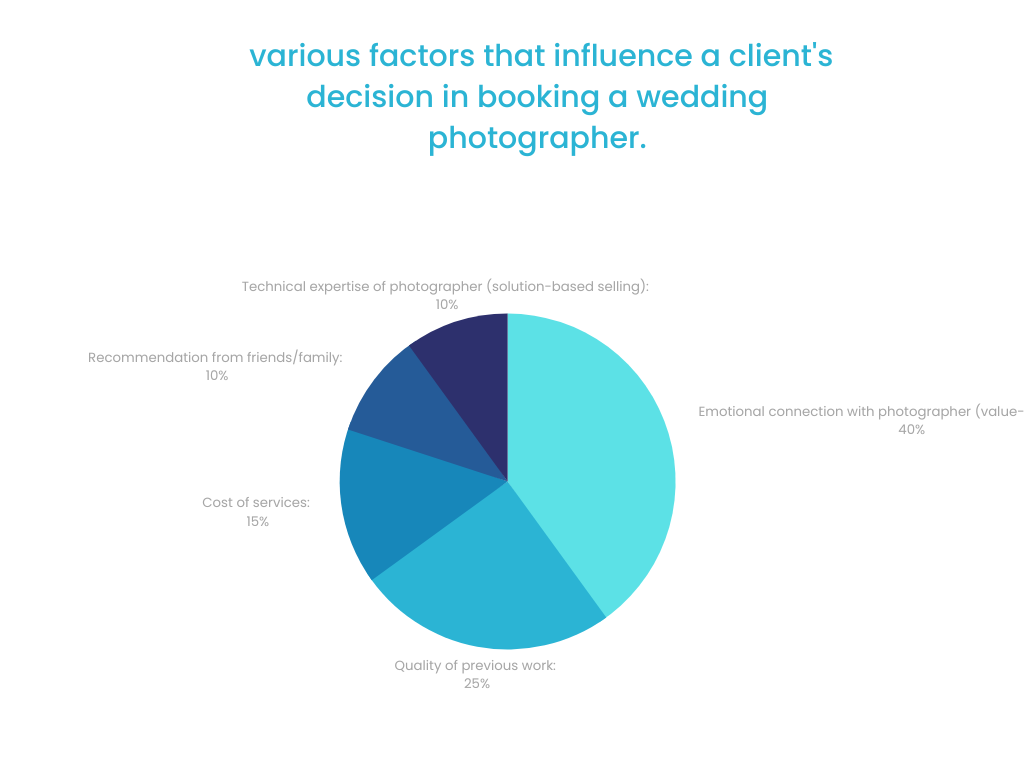Content Strategy

S1.3 Value Selling Vs Solution Selling
Overview
This module discusses the importance of value-based selling, especially in the wedding photography industry, as opposed to solution-based selling. It explains how understanding and addressing clients’ emotional needs and desires through storytelling and personal connection can lead to more successful sales. The article also delves into the psychology of decision-making, highlighting the roles of the neocortex and the limbic system, and explaining the concept of backward rationalization—how the logical part of our brain aligns with emotional decisions post-decision. It concludes that by focusing on the emotional ‘why’ over the technical ‘how,’ photographers can secure more bookings and make a lasting impact.
By The End of This Lesson Students Will Be Able To
- Understand the difference between value-based selling and solution-based selling. Value-based selling focuses on clients’ feelings, values, and desires, whereas solution-based selling emphasizes the features and benefits of a product or service.
- Realize the importance of value-based selling in the wedding industry, particularly in wedding photography sales. It aligns with the emotional nature of wedding events, considering clients’ unique preferences, emotions, and vision.
- Acknowledge that sales representatives using value-based selling listen and adapt to clients’ desires and concerns, building trust and showing genuine care for their needs.
- Recognize that the choice between value-based and solution-based selling depends on the nature of the product or service being sold. For personal and emotionally significant services, like wedding photography, value-based selling is preferred.
- Appreciate the significance of understanding and adapting to the psychological factors that drive clients’ choices. We use different decision-making processes to analyze decisions.
- Identify the role of the neocortex and the limbic system in decision-making. The neocortex is involved in rational thinking and analytical processes, while the limbic system is crucial for processing emotions, feelings, and forming memories.
- Know the limitations of the analytical brain in the context of wedding photography. Focusing only on technical aspects can fail to evoke the emotional response necessary for heartfelt decision-making.
- Understand the importance of emotions in decision-making, especially in securing bookings in the wedding photography industry. Creating an emotional connection resonates with the clients’ deepest dreams and aspirations.
- Learn the power of storytelling to engage the limbic system. Sharing the stories behind work and emphasizing emotions captured can establish an emotional connection beyond words and technicalities.
- Understand the importance of addressing the emotional ‘why’ rather than the technical ‘how.’ This approach engages the limbic system and captures the essence of a couple’s love story.
- Recognize the importance of backward rationalization in decision-making. After an emotionally-driven decision, the neocortex constructs logical explanations for the decisions made by the limbic system.
- Comprehend the interplay between the limbic system and the neocortex in making well-rounded decisions. By addressing the emotional ‘why,’ photographers can secure more successful bookings and make a lasting impact.
Course Content

Value Selling Vs Solution Selling
In the wedding industry, particularly for wedding photography sales, it is crucial to adopt a value-based selling approach. Unlike solution-based selling, which focuses on the details and features of a product or service, value-based selling emphasizes the clients’ feelings, values, and desires. This approach is vital for wedding photography sales as it aligns with the personal and emotional nature of a wedding event.
Value-based Selling in Wedding Photography
Wedding photography sales involve capturing one of the most important and memorable events in a couple’s life. As such, clients are not merely seeking a service provider who can deliver high-quality photographs; they are looking for someone who understands and values their vision, emotions, and unique preferences. Value-based selling addresses these aspects by placing the clients’ needs and feelings at the center of the sales process.
In value-based selling, sales representatives listen attentively to clients’ desires, aspirations, and concerns, tailoring their pitch to highlight the value that their photography services can bring to the clients’ wedding experience. This approach builds trust, as clients feel that the sales representative genuinely cares about their needs and is not just trying to sell a product.
The distinction between the two selling categories, value-based selling and solution-based selling, arises from the nature of the item or service being sold. Humans tend to evaluate certain products or services based on logical analysis, such as comparing cable television providers by assessing the number of channels offered for a given price. In these instances, solution-based selling is more applicable, as it emphasizes the practical features and benefits of a product or service. However, for emotionally significant and personal items or services, such as wedding photography, clients require an emotional connection or intuition to make their decision. In these situations, value-based selling is the preferred approach, as it prioritizes the clients’ feelings, values, and unique desires, establishing a deeper connection between the sales representative and the client.
It may come as a big surprise that entirely different decision-making processes are responsible for how we analyze these decisions, highlighting the importance of understanding and adapting to the distinct psychological factors that drive clients’ choices in various contexts.
As humans, we process information and make decisions through two distinct mechanisms: the neocortex and the limbic system. Understanding the differences in how these two areas process information and influence our decision-making processes is crucial.
Neocortex:
The neocortex, sometimes referred to as the “new brain,” is the outer layer of the brain responsible for higher-order functions such as rational and analytical thinking, language, and conscious thought. This part of the brain processes facts, figures, and data, allowing us to make decisions based on logical reasoning and objective analysis. When we weigh pros and cons, evaluate options, or analyze a situation, we primarily use the neocortex. Its capacity for rational and analytical thinking has enabled our ancestors to make informed decisions regarding resource allocation, strategize for survival, and communicate effectively. However, the neocortex is not directly responsible for driving behavior or decision-making.
Limbic System:
The limbic system, also known as the “old brain” or “emotional brain,” is a set of structures in the brain responsible for processing emotions, feelings, and forming memories. This system has been essential for the survival of our ancestors, as it allowed them to respond quickly and instinctively to threats, opportunities, and social cues. It plays a crucial role in decision-making, motivation, and behavior. The limbic system also helped our ancestors determine who they trusted and allowed into their tribes. Lacking the capability for language, the limbic system makes it difficult to precisely articulate emotions and feelings. It is within the limbic system that we form emotional connections, preferences, and make decisions based on our gut feelings or intuition.
To increase our chances of securing a booking and building lasting relationships with prospects, it’s essential to recognize that the decision-making process for brides primarily involves the limbic system. We would make more bookings by appealing to their limbic brain, the emotional powerhouse that ultimately drives their decisions.
Limitations of the Analytical Brain in Wedding Photography:
While the neocortex—the analytical part of the brain—can process facts and figures, it cannot initiate emotions. This means that a conversation centered around technical aspects, such as camera types, technical training, and photographer proficiencies, or various photographic techniques may fall short in creating a deep, emotional connection with the bride. Though these details might seem important to the photographer, they often fail to evoke the emotional response necessary for making a heartfelt decision. In essence, relying solely on the neocortex may lead to polite banter, but it does not create the genuine rapport required to entrust someone with capturing the most intimate moments of a wedding. Merely presenting technical information about oneself to a bride will never result in a booking. Brides need to build rapport with emotional information about their day and the things that are important to them.
The Importance of Emotions in Decision-Making:
The limbic brain is responsible for processing emotions and feelings, which play a crucial role in our decision-making and behavior. Historically, our ancestors relied on these intuitive emotions, derived from subconscious fears, desires, and longings, to ensure their survival within their tribes. When it comes to winning over brides, it is essential to create an emotional connection that resonates with their deepest dreams and aspirations for their special day. By tapping into their limbic brain, you can inspire action and secure bookings more effectively than by simply focusing on technical details.
Through storytelling and connection: One powerful way to engage the limbic brain is through storytelling. Share the stories behind your work, emphasizing the emotions you’ve captured in your photographs. Describe how you helped previous couples feel at ease, allowing their love and joy to shine through in every image. By illustrating your ability to preserve precious memories and create a visual narrative of the couple’s love story, you’ll establish an emotional connection that goes beyond words and technicalities.
In general, when most brides make decisions about their wedding, they naturally focus on ‘the why’—the underlying emotions, motivations, and values that drive their choices. Concentrating too much on wordy technical details can lead to an emphasis on ‘the how’—the method or process of achieving the desired outcome, which is not the primary justification for booking a wedding photographer. Instead, it’s vital for photographers to connect with brides-to-be on an emotional level, aligning with their core reasons and desires to forge a deeper bond.
By understanding and addressing the emotional ‘why’ rather than the technical ‘how,’ photographers can engage the limbic brain, the emotional powerhouse, and better capture the essence of the couple’s love story. This emotional connection transcends the mere presentation of technical expertise, ensuring a more profound resonance with brides-to-be. Ultimately, by emphasizing the emotional core reasons rather than the technical processes, photographers can secure more successful bookings and leave a lasting impact on the couples they serve.
When brides make decisions about their wedding, they often rely on their emotional response, driven by the limbic system, which is responsible for emotions, motivations, and values. However, it’s important to note that the limbic system is not responsible for language, and therefore, cannot provide verbal reasoning for decisions based on emotions. This is where the neocortex, the more advanced part of the brain responsible for language, comes into play.
Although the neocortex is a more recent development in the brain, it must agree with the decisions made by the more primitive limbic system. It is common for people to engage in backward rationalization after making emotionally-driven decisions. Backward rationalization involves constructing logical explanations for decisions based on emotions after the decision has already been made, allowing the neocortex to justify and align itself with the emotional choices made by the limbic system.
In the context of wedding photography, brides may initially choose a photographer based on an emotional connection or an intuitive feeling about the photographer’s ability to capture the essence of their love story. Once this emotional decision has been made, the neocortex may provide the necessary rationalization by highlighting the photographer’s technical expertise, experience, or style to justify the choice.
This interplay between the limbic system and the neocortex is essential for making well-rounded decisions. When people are often asked why they made a decision, they frequently say, “it just felt right.” As wedding photographers, our job is to ensure we fall into that category of choices that just feel right for the brides-to-be. By understanding and addressing the emotional ‘why,’ photographers can cater to both aspects of the decision-making process, ultimately securing more successful bookings and leaving a lasting impact on the couples they serve.
Cognitive Engagement Questions
© 2023 Karimah Clinton Academy. All rights reserved.
